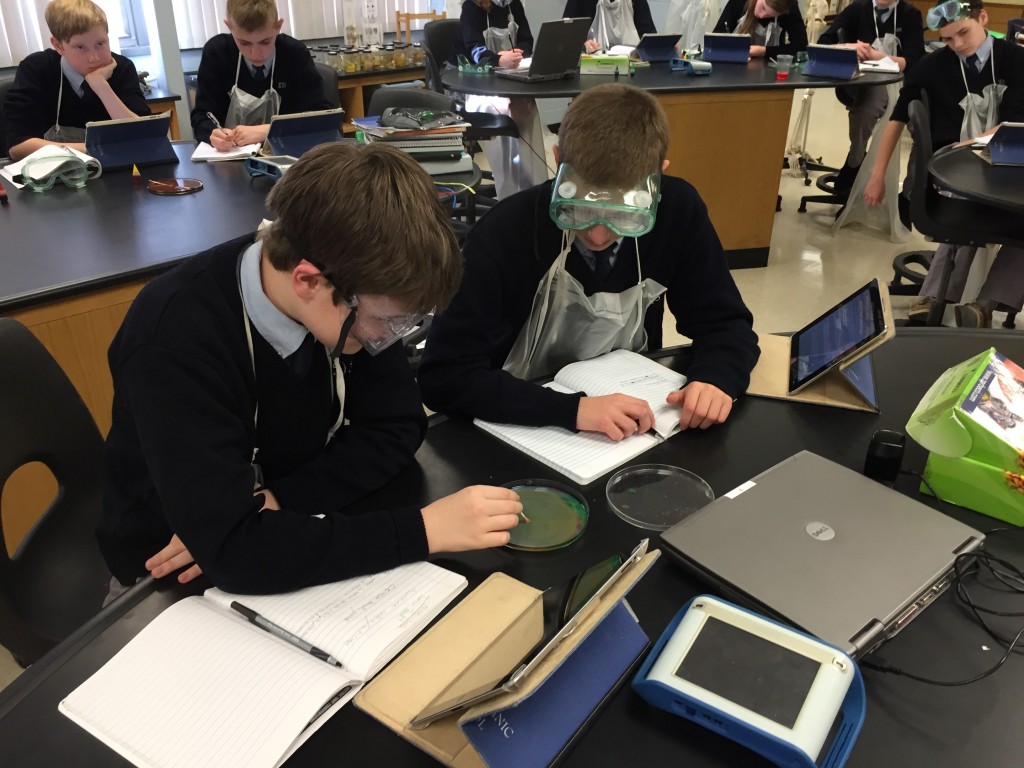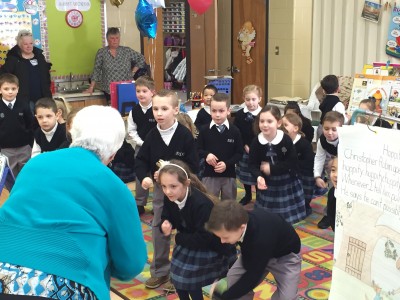
Students in Joanne Arnold’s science class at. St. Dominic School in Brick work on a project on chemical bonding. (Photo: Daniel Nee)
Students in Joanne Arnold’s chemistry class carefully dipped Q-tips into a tube of solution inside the newly-built science lab at St. Dominic School in Brick one morning this week, demonstrating the difference between covalent and ionic chemical bonds. Downstairs, kindergartners were learning a song about Chinese culture to celebrate Chinese New Year, while down the hall, Robert Zolkiewicz, the school director of technology, readied computers for students to write a program that would control a robot the school recently purchased.
St. Dominic, nearly filled to capacity with students in grades kindergarten through eight, is breaking apart both stereotypes and what is becoming a heartbreaking reality for Catholic schools. Once thought of as outdated in technology and behind the times in lessons on world culture, Brick Township’s only Catholic school is thriving, focusing its curriculum on a heaping dose of science, technology, engineering and mathematics and filling its classrooms to the point where an addition to the school was opened in 2009.
|
|
As Catholic schools surrounding Brick – St. Denis School in Manasquan and Holy Family School in Lakewood, plus Mater Dei High School in Middletown – close their doors, St. Dominic is attracting local families with a rigorous, modern curriculum that is complimented with Christian values.
This year, St. Dominic is celebrating its 50th year in existence.
“We have a very supportive parish community, and [Pastor] Msgr. Brady has really been a visionary, adding a whole new wing and a media center, science lab and all sorts of new technology,” explained principal Carol Bathmann. “The students have digital techbooks. Some schools have regular, hardcover books you can access online, but these are completely digital. We saw them at a conference, the International Society for Technology in Education conference in Atlanta, and we knew we had to stay current. These ‘books’ are constantly being updated.”
At a time when parents are increasingly concerned about Common Core standards and increased testing in public schools, St. Dominic has taken an approach of “adapting to, but not adopting” the Common Core, giving teachers more leeway in their instruction while adapting the overall curriculum so students can meet and, according to school officials, exceed their counterparts elsewhere.
The school currently has 528 students enrolled, with a capacity of just about 600, Bathmann said.
“We’re pretty full right now,” she added, with each grade having between 50 and 60 students.

A kindergarten class sings a song about Chinese New Year at St. Dominic School, Brick. (Photo: Daniel Nee)
St. Dominic has differentiated itself not just in terms of curriculum as a whole, but with years’ worth of investments in technology, apparent in the school’s ultra-modern media center in its new wing, and its computer lab that features Nao, a humanoid robot that is usually reserved for college students taking introductory programming courses, said Zolkiewicz, the technology director.
“Up until very recently, these were only sold to colleges and universities,” said Zolkiewicz. “We got him in the last year.”
“When we say ‘robot,’ everybody usually thinks of Rosie from The Jetsons, but it’s really a learning tool,” Zolkiewicz explained, as Nao came to life, welcoming a reporter into the computer lab.
In a Windows-based programming suite, students can write their own programs that can control what Nao can do, from kicking a soccer ball, to waving hello, to walking across the room and delivering a message to another student.
“We use it to teach the kids the fundamentals of programming,” said Zolkiewicz.
The school is also participating in Code.org, an initiative founded by Facebook CEO Mark Zuckerberg that asks schools to dedicated an hour each day to technology.
“We go beyond that,” Zolkiewicz said, “things like assignment statements, executable statements, variables, iPad apps, then programming the robot.”
The school science lab, built in the former library after the addition was opened, features plenty of room for experiments, machines that automatically sanitize goggles and separate areas for students in the lower grades and upper grades designed to be conducive to group learning.
“We study genetics, which is especially important for when our students go to high school, and chemistry in the eighth grade,” said Arnold. “They learn the periodic table, balancing equations, ionic and covalent bonds.”
Arnold is the curriculum chair for science in the Diocese of Trenton and has been with St. Dominic for over 30 years.
As part of St. Dominic’s 50 year anniversary, the school celebrated with a large program highlighting each of the decades last week, complete with food, displays made by students and an appearance by Mayor John Ducey.
Bathmann said going forward, the vision for the school is to continue to build its curriculum and technology by having staff attend national and international conferences, infuse more technology into lessons and keep grounded with at atmosphere of both friendliness, parent involvement and faith.
“We’ve really brought everything into the 21st century,” Bathmann said.













